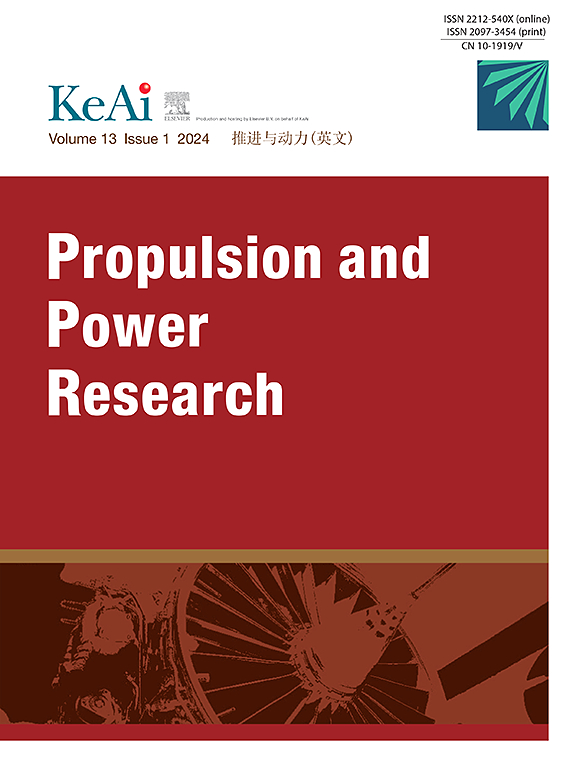用于改善高负荷压缩机级联性能的自适应科恩达喷气控制
IF 5.4
2区 工程技术
Q1 ENGINEERING, AEROSPACE
引用次数: 0
摘要
燃气轮机是一种很有前途的发电和推进装置,可以使用传统或可再生能源燃料。压气机的流动不稳定性是其关键问题之一,特别是随着叶片负荷的增加和工作环境的变化。为了智能有效地抑制高负荷压气机在变工况下的流动分离,提高压气机的升压能力,针对扩散系数为0.66的压气机定子叶栅,提出了一种新的流动控制技术——自适应康达射流控制(ACJC)。为实现ACJC策略,采用单因素方差分析、主成分分析和反向传播神经网络(BPNN)方法,建立了入射角(IA)预测模型和最优注射质量流量(OIMFR)预测模型。考虑0.1和0.4两个进气道马赫数分别代表不可压缩和可压缩两种流动状态,并采用不同的进气道入射角来模拟真实压气机的各种非设计工况。通过数值模拟来评估ACJC系统的有效性,了解喷射质量流量比对叶栅流场和气动性能的影响。结果表明,ACJC系统能够准确预测在各个入射角下实现最小流动损失的最佳喷射质量流量比。与无ACJC的叶栅相比,在5°入射角下,最优喷射质量流量比为1.27%和1.20%时,来流马赫数为0.1和0.4时,总压损失系数分别降低18.88%和21.56%。本文章由计算机程序翻译,如有差异,请以英文原文为准。
Adaptive Coanda jet control for performance improvement of a highly loaded compressor cascade
Gas turbine is a promising device for power generation and propulsion either using traditional or renewable energy fuels. One of its key problems is the flow instability of compressors especially with the increase in blade load and changeable working environment. To intelligently and efficiently inhibit flow separation and enhance the pressure rise ability of highly loaded compressors under variable operating conditions, a novel flow control technique termed as adaptive Coanda jet control (ACJC) is proposed in this paper for a compressor stator cascade with a high diffusion factor of 0.66. To realize the ACJC strategy, an incidence angle (IA) prediction model and an optimal injection mass flow rate (OIMFR) prediction model are established by adopting single factor analysis of variance, principal component analysis and Back Propagation Neural Network (BPNN) methods. Two inlet Mach numbers including 0.1 and 0.4 are considered to represent incompressible and compressible flow conditions, and different inlet incidence angles are involved to model various off-design working situations of the real compressor. Effectiveness of the ACJC system is evaluated using numerical simulations are performed to understand the effects of the injection mass flow ratio on the flow field and aerodynamic performance of the blade cascade. Results indicate that the ACJC system can accurately predict the optimal injection mass flow ratio that can achieve the minimum flow loss at each incidence angle. Compared to the cascade without ACJC under the incidence angel of 5°, the optimal injection mass flow ratio being 1.27% and 1.20% can reduce the total pressure loss coefficient by 18.88% and 21.56% for incoming Mach number being 0.1 and 0.4, respectively.
求助全文
通过发布文献求助,成功后即可免费获取论文全文。
去求助
来源期刊

Propulsion and Power Research
Multiple-
CiteScore
7.50
自引率
5.70%
发文量
30
期刊介绍:
Propulsion and Power Research is a peer reviewed scientific journal in English established in 2012. The Journals publishes high quality original research articles and general reviews in fundamental research aspects of aeronautics/astronautics propulsion and power engineering, including, but not limited to, system, fluid mechanics, heat transfer, combustion, vibration and acoustics, solid mechanics and dynamics, control and so on. The journal serves as a platform for academic exchange by experts, scholars and researchers in these fields.
 求助内容:
求助内容: 应助结果提醒方式:
应助结果提醒方式:


